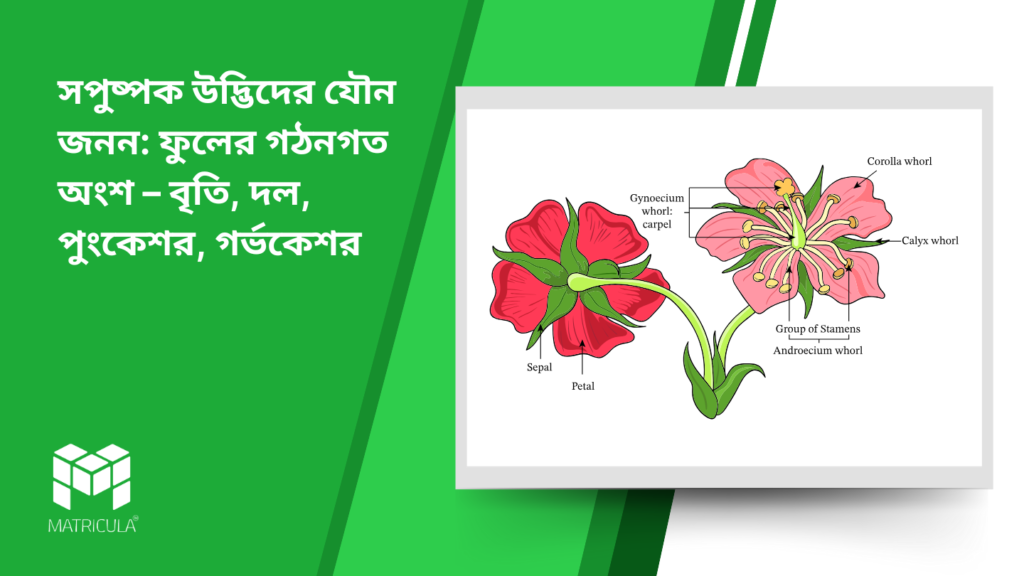Introduction
Flowering plants, also known as angiosperms, reproduce sexually through flowers, which are their reproductive structures. A flower consists of different parts, each with a specific function in reproduction. These structural parts can be broadly categorized into two groups—vegetative parts (which do not directly participate in reproduction) and reproductive parts (which are directly involved in fertilization).
In this article, we will explore the four main structural parts of a flower—Calyx, Corolla, Androecium, and Gynoecium, their roles in reproduction, and their significance in the life cycle of a flowering plant.
1. Calyx: The Protective Outer Layer
The calyx is the outermost whorl of a flower, consisting of small leaf-like structures called sepals. It plays a crucial role in protecting the developing bud before blooming.
Functions of Calyx:
- Acts as a protective covering for the flower bud, shielding it from physical damage, harsh weather, and insect attacks.
- In some plants, the sepals remain even after the flower blooms, aiding in photosynthesis and providing additional support.
- In certain species, the sepals turn colorful and help attract pollinators, a feature called petaloid sepals (e.g., in Gulmohar).
2. Corolla: The Attractive Petal Layer
The corolla is the second whorl of the flower, made up of petals, which are usually brightly colored and fragrant. This whorl plays a significant role in attracting pollinators such as bees, butterflies, and birds.
Functions of Corolla:
- Enhances the visual appeal of the flower, making it attractive to pollinators.
- The scent and nectar produced by the petals help in enticing insects and birds, which assist in pollination.
- Acts as a protective layer for the reproductive organs located at the center of the flower.
- Some flowers exhibit nectar guides, which are markings on the petals that direct pollinators towards the nectar.
3. Androecium: The Male Reproductive Whorl
The androecium is the male reproductive part of the flower, consisting of multiple stamens. Each stamen is made up of two parts:
- Anther – A sac-like structure that produces and stores pollen grains, which contain male gametes.
- Filament – A stalk that holds the anther in place, ensuring proper exposure for pollen dispersal.
Functions of Androecium:
- Produces and releases pollen grains, which are essential for fertilization.
- Ensures the transfer of pollen to the female reproductive organ through pollination (either self-pollination or cross-pollination).
- Some anthers open through pores or slits, facilitating easy pollen dispersal by wind, water, or pollinators.
4. Gynoecium: The Female Reproductive Whorl
The gynoecium is the female reproductive part of the flower and consists of one or more carpels (or pistils). Each carpel is made up of three main parts:
- Stigma – The uppermost, sticky surface where pollen grains land and adhere during pollination.
- Style – A slender stalk that connects the stigma to the ovary, allowing pollen tubes to travel to the ovules.
- Ovary – The swollen base that contains ovules (female gametes). After fertilization, the ovary develops into a fruit, and the ovules become seeds.
Functions of Gynoecium:
- Acts as the site for fertilization, where pollen grains germinate and reach the ovules.
- Protects the ovules inside the ovary, ensuring successful reproduction.
- After fertilization, the ovary undergoes fruit formation (fructification), which aids in seed dispersal.
Conclusion
The calyx, corolla, androecium, and gynoecium together form the essential structural parts of a flower, each contributing to the plant’s reproductive cycle. While the calyx and corolla offer protection and attract pollinators, the androecium and gynoecium play a direct role in sexual reproduction. Understanding these parts is crucial for comprehending pollination, fertilization, and seed formation in flowering plants.
This knowledge is fundamental in botany, agriculture, and horticulture, as it helps in plant breeding, improving crop yield, and conserving biodiversity.
Keywords:
Sexual reproduction in plants, parts of a flower, calyx function, corolla role, androecium structure, gynoecium function, male reproductive part of flower, female reproductive part of flower, pollination, fertilization, seed formation in plants.
সপুষ্পক উদ্ভিদের যৌন জনন: ফুলের গঠনগত অংশ – বৃতি, দল, পুংকেশর, গর্ভকেশর
ভূমিকা
সপুষ্পক উদ্ভিদ বা অ্যাঞ্জিওস্পার্ম (Angiosperms) তাদের প্রজনন প্রক্রিয়ার জন্য ফুলের উপর নির্ভর করে। ফুল হল উদ্ভিদের প্রজনন অঙ্গ, যা বিভিন্ন অংশ নিয়ে গঠিত। এসব অংশকে মূলত দুই ভাগে ভাগ করা যায়—
- অপ্রজনন অংশ (যা সরাসরি প্রজননের সাথে যুক্ত নয়)
- প্রজনন অংশ (যা নিষেক প্রক্রিয়ায় সক্রিয়ভাবে অংশগ্রহণ করে)
এই নিবন্ধে, আমরা ফুলের চারটি প্রধান গঠনগত অংশ—বৃতি (Calyx), দল (Corolla), পুংকেশর (Androecium) এবং গর্ভকেশর (Gynoecium) সম্পর্কে বিস্তারিত আলোচনা করব।
১. বৃতি (Calyx): ফুলের বাইরের প্রতিরক্ষামূলক স্তর
বৃতি হলো ফুলের বহিঃস্থ স্তর, যা বৃন্তক (Sepals) নামক ছোট পাতার মতো গঠন দ্বারা গঠিত। এটি ফুলের কুঁড়িকে (Bud) সুরক্ষিত রাখে এবং ফুল ফোটার আগে বিভিন্ন ক্ষতি থেকে রক্ষা করে।
বৃতির কার্যাবলি:
- ফুলের কুঁড়িকে শারীরিক ক্ষতি, প্রতিকূল আবহাওয়া, এবং পোকামাকড়ের আক্রমণ থেকে রক্ষা করে।
- কিছু উদ্ভিদে বৃন্তক ফুল ফোটার পরেও বিদ্যমান থাকে এবং সরাসরি আলোকসংশ্লেষণে (Photosynthesis) সাহায্য করে।
- কিছু ক্ষেত্রে, বৃন্তক রঙিন হয়ে পরাগবাহীদের আকৃষ্ট করতে সাহায্য করে, যেমন গুলমোহরের ক্ষেত্রে।
২. দল (Corolla): রঙিন পাপড়ির স্তর
দল হলো ফুলের দ্বিতীয় স্তর, যা পাপড়ি (Petals) দ্বারা গঠিত। এটি সাধারণত উজ্জ্বল রঙের এবং সুগন্ধযুক্ত হয়, যা পরাগবাহী পতঙ্গ ও প্রাণীদের আকৃষ্ট করতে সাহায্য করে।
দলের কার্যাবলি:
- পরাগবাহীদের আকৃষ্ট করে, ফলে পরাগসংযোগ (Pollination) সহজ হয়।
- কিছু ফুলে পাপড়ির উপর নেক্টার গাইড (Nectar Guide) থাকে, যা পরাগবাহীদের সঠিক দিকে পরিচালিত করে।
- ফুলের প্রজনন অঙ্গগুলিকে সুরক্ষা দেয়।
৩. পুংকেশর (Androecium): ফুলের পুরুষ প্রজনন অঙ্গ
পুংকেশর হলো ফুলের পুরুষ প্রজনন অংশ, যা একাধিক পুংদণ্ড (Stamen) দ্বারা গঠিত। প্রতিটি পুংদণ্ড দুটি অংশ নিয়ে গঠিত—
- পরাগধানী (Anther) – এটি পরাগকণা (Pollen Grains) উৎপন্ন করে, যা পুরুষ গ্যামেট বহন করে।
- পুংসূত্র (Filament) – এটি পরাগধানীকে ধরে রাখে, যাতে পরাগ সংযোগ সহজ হয়।
পুংকেশরের কার্যাবলি:
- পরাগ উৎপাদন ও বিস্তার করে, যা নিষেকের জন্য অত্যন্ত গুরুত্বপূর্ণ।
- পরাগকণা ফুলের স্ত্রী প্রজনন অঙ্গে (গর্ভকেশর) স্থানান্তর করতে সাহায্য করে।
- কিছু পরাগধানী বাতাস, জল বা পরাগবাহীদের মাধ্যমে পরাগ ছড়িয়ে দেয়।
৪. গর্ভকেশর (Gynoecium): ফুলের স্ত্রী প্রজনন অঙ্গ
গর্ভকেশর হলো ফুলের স্ত্রী প্রজনন অংশ, যা এক বা একাধিক গর্ভদণ্ড (Carpel/Pistil) দ্বারা গঠিত। প্রতিটি গর্ভদণ্ড তিনটি প্রধান অংশ নিয়ে গঠিত—
- গর্ভমুন্ড (Stigma) – ফুলের উপরের অংশ, যেখানে পরাগকণা জমা হয়।
- গর্ভনালি (Style) – এটি গর্ভমুন্ডকে গর্ভাশয়ের সাথে সংযুক্ত করে এবং পরাগনলীর মাধ্যমে পরাগকণা গর্ভাশয়ে পৌঁছতে সাহায্য করে।
- গর্ভাশয় (Ovary) – এটি ফুলের স্ত্রী গ্যামেট (Ovule) ধারণ করে এবং নিষেকের পর ফল ও বীজে রূপান্তরিত হয়।
গর্ভকেশরের কার্যাবলি:
- পরাগ গ্রহণ ও নিষেকের জন্য প্রস্তুত থাকে।
- পরাগকণা থেকে উৎপন্ন পরাগনলী (Pollen Tube) এর মাধ্যমে গর্ভাশয়ে গ্যামেট স্থানান্তর নিশ্চিত করে।
- নিষেকের পর, গর্ভাশয় ফল এবং গর্ভধারিত ডিম্বাণু বীজে পরিণত হয়।
উপসংহার
ফুলের চারটি প্রধান অংশ—বৃতি, দল, পুংকেশর, এবং গর্ভকেশর—একসঙ্গে ফুলের গঠন ও প্রজনন প্রক্রিয়ায় গুরুত্বপূর্ণ ভূমিকা পালন করে। বৃতি ও দল পরাগবাহীদের আকৃষ্ট করতে এবং ফুলকে সুরক্ষা দিতে সাহায্য করে, যখন পুংকেশর ও গর্ভকেশর যৌন জননের জন্য অপরিহার্য।এটি পরাগসংযোগ, নিষেক, ও বীজ উৎপাদনের মতো গুরুত্বপূর্ণ প্রক্রিয়াগুলির ভিত্তি তৈরি করে, যা উদ্ভিদবিজ্ঞানের পাশাপাশি কৃষি, উদ্যানপালন ও জীববৈচিত্র্য সংরক্ষণেও গুরুত্বপূর্ণ।




